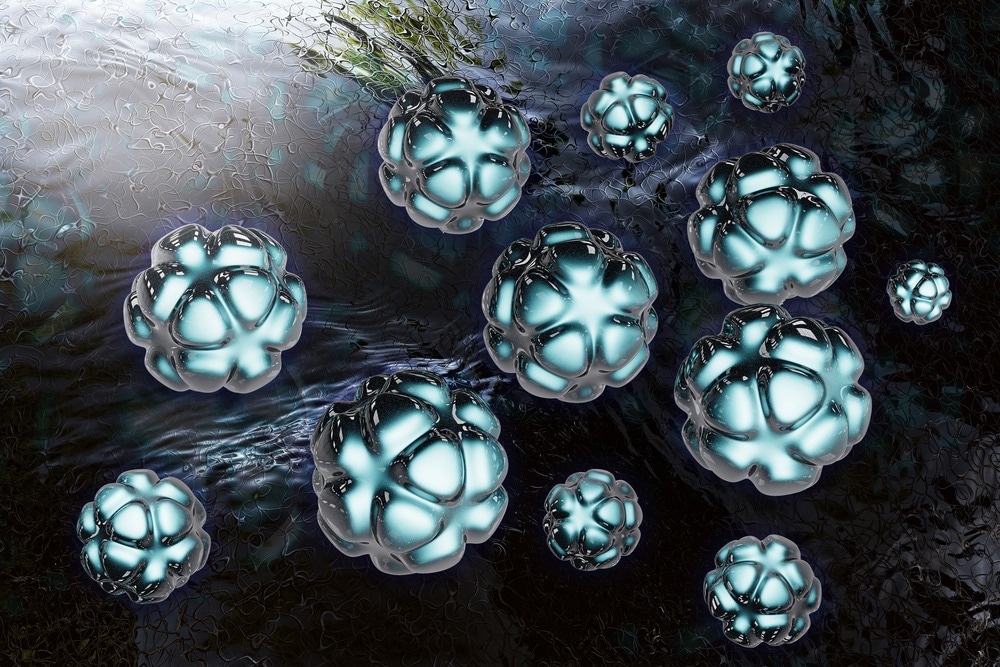The transmission, enrichment, and separation of nanoparticles are key processes in biochemistry, physiology, pharmacology, and materials sciences. A recent study published in Science Advances presents a unique method for separating nanoparticles using a specifically designed fan-shaped acoustic device.

Study: Self-adaptive virtual microchannel for continuous enrichment and separation of nanoparticles. Image Credit: xrender/Shutterstock.com
Nanoparticles
Nanoparticles are one of the most researched topics in materials sciences and engineering, with applications in the chemical, medicinal, optical, and electrical sectors. Due to their distinct biological activities and characteristics, bionanoparticles such as exosomes, viruses, and extracellular vesicles (EVs) have gained substantial research interest during the last decade.
The separation of nanoparticles, in addition to their purification and enrichment, is a fundamental requirement for many of their applications. For instance, uniform nanoparticles are favored as medication carriers due to their lengthy blood circulation durations, whereas nanoparticles with broad size dispersion can have unanticipated harmful effects.
Microfluidic Devices for Separation of Nanoparticles
Standard techniques for the filtration and separation of nanoparticles include now density gradient extraction, size exclusion chromatography, and membrane filtering. However, these bulk techniques often need a minimum sample volume, rendering them inapplicable for unique medical or biological specimens.
It has previously been established that miniature microfluidic devices are useful instruments for the enrichment and separation of nanoparticles, particularly in small-volume specimens. Due to these processes' comparatively low Reynolds numbers, a homogenous force field and constant flow conditions are preserved throughout the separation phase, allowing for excellent efficiency.
Microfluidic systems are generally characterized as passive, which employ inertial fluids to compress suspended nanoparticles at particular places in the channel, or active, which employ external pressures to move particles laterally to their equilibrium points.
Challenges Associated with Microfluidic Devices
Despite the significant potential, no commercially viable microfluidic devices for the enrichment and separation of nanoparticles are presently available. Microfluidic devices currently used are too large to manage particles less than 100 nanometers in size.
Once the particulate size is lowered to the submicrometric scale, drag forces caused by fluid motion typically dominate particle mobility. As a result, manipulating nanoparticles with externally applied force fields becomes extremely challenging.
Moreover, developing a "one-size-fits-all" microfluidic device for separating nanoparticles of varying sizes is still problematic. Bionanoparticles are frequently encountered in complicated combinations with different physiochemical characteristics. This drastically restricts the use of microfluidic systems for manipulating and separating nanoparticles.
Acoustofluidics: A Novel Approach for Separation of Nanoparticles
In this context, a unique method for separating nanoparticles that is tolerant of diverse kinds and concentrations of materials while preserving operating efficiency is urgently required.
Acoustofluidics, the combination of acoustics with microfluidics, is one possible method for achieving this goal.
In this study, the researchers present a unique acoustofluidics technique for synthesizing and separating nanoparticles using a specifically built fan-shaped acoustic device. A virtual channel is created by a sequence of closed and linked micro vortices prompted by an ultrahigh-frequency bulk acoustic wave (UHF BAW) and constrained by microfluidics.
Because the channel is virtual and there is no actual substructure, obstruction and nanoparticle damage caused by solid components such as filters or pillars are eliminated. The high-speed spinning micro vortices create substantial drag forces, aiding the separation of nanoparticles.
Key Findings of the Study
The targeted nanoparticles could be effectively contained inside the virtual channel and pushed further by the lateral circulation. The distinctive vibration frequency and device configuration kept the plane of the sonic vortices perpendicular to the lateral flow, enhancing the focusing ability of the channel.
The dynamic equilibrium between particle contacts and acoustic forces was primarily responsible for the effective separation of nanoparticles. To adapt to changing sample volumes, the virtual channel's inner diameter could be greatly modified using the acoustic fields.
The recovery percentage of the 150-nm, 200-nm, and 300-nm polystyrene nanoparticles in particulate focusing-type enrichment were 54.5, 85.6, and 92.6 percent, respectively. To test the overall system performance and cytocompatibility, exosomes smaller than 150 nanometers were successfully isolated from plasma.
Based on these findings, it is safe to suggest that the self-adaptive microchannel developed in this study provides a novel and universal strategy for the enrichment and separation of nanoparticles.
Reference
Yang, Y. et al. (2022). Self-adaptive virtual microchannel for continuous enrichment and separation of nanoparticles. Science Advances. Available at: https://www.science.org/doi/10.1126/sciadv.abn8440
Disclaimer: The views expressed here are those of the author expressed in their private capacity and do not necessarily represent the views of AZoM.com Limited T/A AZoNetwork the owner and operator of this website. This disclaimer forms part of the Terms and conditions of use of this website.